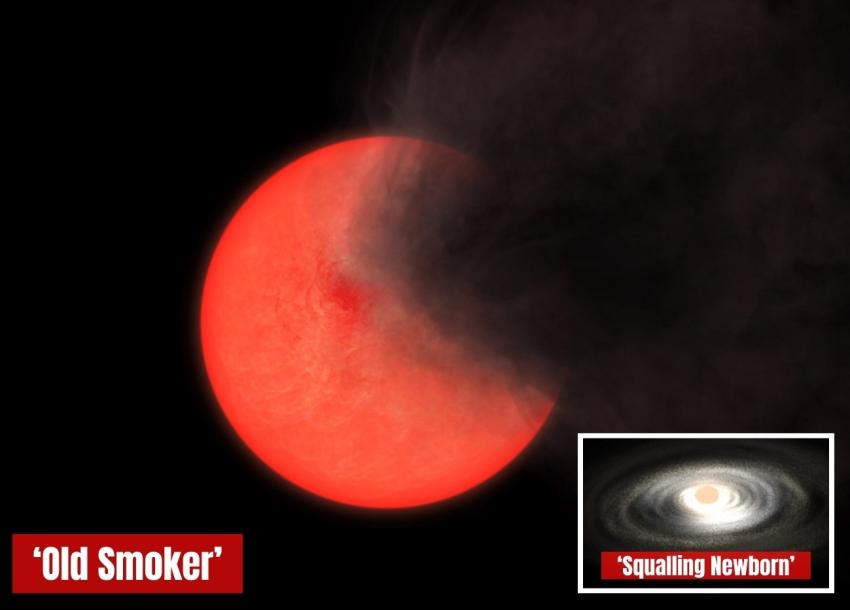
Credit
Philip Lucas/University of Hertfordshire
Licence type Attribution (CC BY 4.0)
‘Hidden’ stars including a new type of elderly giant nicknamed an ‘old smoker’ have been spotted for the first time by astronomers.
The mystery objects exist at the heart of our Milky Way galaxy and can sit quietly for decades – fading almost to invisibility – before suddenly puffing out clouds of smoke, according to a new study published today in the Monthly Notices of the Royal Astronomical Society.
An international team of scientists led by Professor Philip Lucas, of the University of Hertfordshire, made their ground-breaking discovery after monitoring almost a billion stars in infrared light during a 10-year survey of the night sky.
They also detected dozens of rarely-seen newborn stars, known as protostars, which undergo extreme outbursts over a period of months, years or decades, as part of the formation of a new solar system.
Most of these newly-spotted stars are hidden from view in visible light by large amounts of dust and gas in the Milky Way — but infrared light can get through, allowing scientists to see them for the first time.
Astronomers from the UK, Chile, South Korea, Brazil, Germany and Italy carried out their research with the help of the Visible and Infrared Survey Telescope (VISTA) — a British-built telescope high in the Chilean Andes at Cerro Paranal Observatory, which is part of the European Southern Observatory (ESO).
The team kept a watchful eye on hundreds of millions of stars and analysed 222 that showed the largest changes in brightness.
Professor Lucas said: “About two-thirds of the stars were easy to classify as well-understood events of various types.
“The rest were a bit more difficult so we used ESO’s Very Large Telescope to get spectra of many of them individually. A spectrum shows us how much light we can see at a spread of different wavelengths, giving a much clearer idea of what we are looking at.”
The work was carried out as part of a long-term survey called ‘VISTA Variables in the Via Lactea’, or VVV.
Dr Zhen Guo, formerly of the University of Hertfordshire and now based at the University of Valparaiso in Chile, led the work on the spectra.
He said: “Our main aim was to find rarely-seen newborn stars, also called protostars, while they are undergoing a great outburst that can last for months, years, or even decades.
“These outbursts happen in the slowly spinning disc of matter that is forming a new solar system. They help the newborn star in the middle to grow, but make it harder for planets to form.
“We don’t yet understand why the discs become unstable like this.”
The team discovered 32 erupting protostars that increased in brightness at least 40-fold, and in some cases over 300-fold.
Most of the eruptions are still ongoing, allowing astronomers for the first time to analyse a large batch of these mysterious events throughout their evolution – from the initial quiescent state, through the peak of brightness, and into the declining stage.
However, the study also threw up something completely unexpected.
There were 21 red stars near the centre of the Milky Way that showed ambiguous changes in brightness during the 10-year survey.
Professor Lucas explained: “We weren’t sure if these stars were protostars starting an eruption, or recovering from a dip in brightness caused by a disc or shell of dust in front of the star — or if they were older giant stars throwing off matter in the late stages of their life.”
Analysis of the spectra for seven of these stars, compared with data from earlier surveys, concluded that they were in fact a new type of red giant star.
Professor Dante Minniti at Andrés Bello University, Chile, founder of the VVV survey, said: “These elderly stars sit quietly for years or decades and then puff out clouds of smoke in a totally unexpected way.
“They look very dim and red for several years, to the point that sometimes we can’t see them at all.”
A further clue about this new discovery lies in the location of these dwindling giant stars. They are heavily concentrated in the innermost part of the Milky Way, known as the Nuclear Disc, a region where stars tend to be richer in heavy elements than anywhere else.
This should make it easier for dust particles to condense out of gas in the relatively cool outer layers of red giant stars. However, how this leads to the ejection of puffs of dense smoke that the team observed remains a mystery.
The researchers said their discoveries could change what we know about the way that elements are distributed across space, as Professor Lucas explains.
“Matter ejected from old stars plays a key role in the life cycle of the elements, helping to form the next generation of stars and planets,” he said.
“This was thought to occur mainly in a well-studied type of star called a Mira variable.
“However, the discovery of a new type of star that throws off matter could have wider significance for the spread of heavy elements in the Nuclear Disc and metal-rich regions of other galaxies.”
https://ras.ac.uk/news-and-press/news/old-smokers-and-squalling-newborns-among-hidden-stars-spotted-first-time









Recent Comments